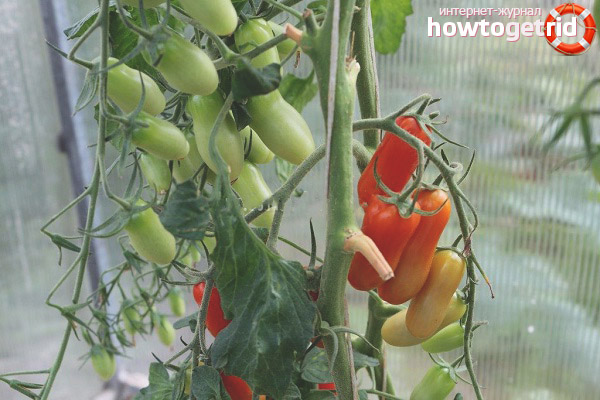The content of the article
Variety bred in Germany. Its name is translated from German into Russian as “bottle tomato”. The ripening rate is medium early variety. However, fruiting is long before the cold snap. In addition, Fleashentomaten is considered high-yielding, suitable for cultivation both in sheltered and in open ground.
Description
Plants of this variety are tall, can reach two meters in height, are indeterminate by the nature of growth, while the bush is characterized by thick stems and a small number of small leaves. The arrangement of fruits is cluster, close. Fruits form a bottle-shaped and bright red color. The peel looks glossy. The pulp has a pronounced aroma and taste. Fruits are suitable both for use in salads and for canning. In addition, the fruits are characterized by good transportability and keeping quality.
Growing recommendations
Plants of this variety can be grown both in open and in protected ground. Before sowing, seeds are recommended to be inspected for defects. Seeding dates are best chosen taking into account the climate in your area and soil protection, that is, given the possible timing of planting in a permanent place.
Roughly seeds can be sown 45-55 days before planting in a permanent place. When planting in open ground, agronomists are usually advised to sow 2-4 weeks later. Some gardeners recommend soaking the seeds for 12 hours. It is also advisable to decontaminate seeds of our own production. Depending on the alleged infection, you can use physical methods, including thermal, as well as chemical and biological drugs. Of the latter, Fitosporin-M, Alirin-B can be called.
When sowing, seeds should be tried to be planted to a depth of 1-2 cm. After sowing, cover with glass or film. Then, if possible, take the seed container to a warm place. After emergence, the film should be removed, and containers with seedlings can be moved to a cooler place.
When two real leaves appear, seedlings must be planted. With a weak growth of seedlings, fertilizing with nitrogen-containing mineral or organic fertilizer may be required. Almost any nitrate, complex fertilizers such as Fertika, Aquarin, Rastvorin are suitable as mineral. To accelerate the development, it is possible to use biological products of the EM series, special stimulants, for example, Zircon, Silk, Narcissus, as well as microfertilizers (Uniflor-micro, etc.). Before landing in a permanent place, hardening is often recommended. If conditions allow, for several hours it is worth exposing seedlings in the open air, for example on a balcony.
Before transplanting seedlings, some vegetable growers recommend scattering humus and some mineral fertilizers, such as superphosphate, ash, etc. If there is a shortage of fertilizers, many gardeners add them to the wells. As an fertilizer, you can use WMD, AVA-station wagon, etc. For 1 square. m you can plant 3-5 plants. It is usually necessary to leave 35-40 cm between plants in a row. With closer placement, especially in a greenhouse, stagnant moist air occurs and plants receive less light.
Care after landing. After planting, planting is usually required for stakes or trellis. Before the blooming of the third flower brush for the prevention of fatliquoring of plants, agronomists are usually advised to do without nitrogen-containing fertilizers. At the same time, phosphorus-potassium fertilizers, for example, ash, potassium monophosphate, are quite appropriate.After blooming of the 3rd flower brush, complex fertilizers, such as Fertika, Zdraven, Mortar, are appropriate.
Formation. Bushes of this variety are usually advised to form in 1, less often 2 stems. Stepsons are recommended to be removed.
Plant protection
Tomato plants can suffer from various diseases, both infectious and physiological. Infectious can be divided into fungal, bacterial, viral and mycoplasma. The most common are fungal, including late blight, cladosporiasis, macrosporiosis. For the prevention of damage, it is recommended to spray first with immunomodulators, for example, immunocytophytes, as well as biofungicides Alirin-B, Bactofit. As chemical fungicides, it is permissible to use a 1% Bordeaux mixture, Ordan, Abiga Peak. Of bacterial diseases, tomatoes are affected by black bacterial spotting and the infectious form of apical rot of fruits.
Video: Fleushentomaten tomatoes










Submit